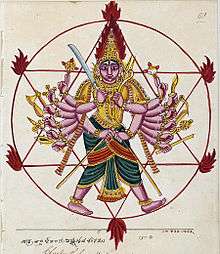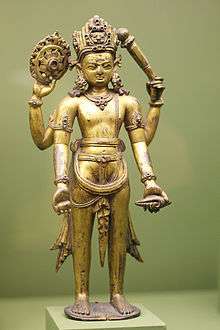Sudarshana Chakra
| Sudarshana Chakra | |
|---|---|
|
Vishnu with Sudarshana Chakra in his right rear hand | |
| Devanagari | सुदर्शन चक्र |
| Affiliation | Weapon of Vishnu |
| Texts | Vishnu Purana |
The Sudarshana Chakra is a spinning, disk-like weapon, literally meaning ring nice in looks, having 108 serrated edges used by the Hindu god Vishnu. The Sudarshana Chakra is generally portrayed on the right rear hand of the four hands of Vishnu, who also holds a shankha (conch shell), a Gada (mace) and a padma (lotus).[1]
The Sudarshana Chakra may be depicted as an ayudhapurusha (anthropomorphic form). He is depicted as a fierce form of Vishnu. While the Sudarshana Chakra is depicted as a subordinate figure with Vishnu, in many South Indian Vishnu temples, the Chakra as an ayudhapurusha is worshipped in its own shrine attached to the central temple.
According to the Puranas, Sudarshana Chakra is used for the ultimate destruction of an enemy. The depiction of Vishnu with Sudarshana Chakra also means that Vishnu is the keeper-owner of the celestial bodies and heavens.
Etymology
The word Sudarshana is derived from two Sanskrit words – Su(सु) meaning "good/auspicious" and Darshana (दर्शन) meaning "vision". Hence, the word Sudarshana collectively means "vision of which is auspicious". Sudarshana is generally worshiped during Homas to ward off negative powers or vibrations.[2]
The word chakra is derived from the word Chruhu (चृ:) meaning movement and kruhu(कृ:) meaning to do. Hence, chakra collectively means the one which is mobile. Among all the Vedic weapons, Sudarshana Chakra is the only mobile weapon.[3]
Legends
There are various legends related to the origins of the Sudarshana Chakra.
As per Valmiki, Ramayana, Purushottama (Vishnu) killed a Danava named Hayagreeva on top of mountain named Chakravan constructed by Vishvakarma and took away Chakra i.e. Sudarshana Chakra from him.
The Sudarshana Chakra was made by the architect of gods, Vishvakarma. Vishvakarma's daughter Sanjana was married to Surya, the Sun God. Due to the Sun's blazing light and heat, she was unable to go near the Sun. She complained to her father about this. Vishvakarma took the Sun and made him shine less so that his daughter would be able to hug the Sun. The left over Sun "dust" was collected by Vishvakarma and made into three divine objects. The first one was the aerial vehicle Pushpaka Vimana, the second being the Trishula (Trident) of the god Shiva, and the third was the Sudarshana Chakra of Vishnu. The Chakra is described to have 10 million spikes in two rows moving in opposite directions to give it a serrated edge.
Sudarshana Chakra is considered to be one of the most powerful weapons in Hindu mythology.[4]
Sudarshana Chakra was used to cut the corpse of Sati, the consort of Shiva into 51 pieces after she gave up her life by throwing herself in a yagna (fire sacrifice) of her father Daksha. It is said that Shiva, in grief, carried around her lifeless body and was inconsolable. The 51 parts of the goddess' body were then tossed about in different parts of the Indian subcontinent and came to be known as "Shakti Peethas".
Sudarshan Chakra is also mentioned in the great war of Mahabharata. Jayadratha was responsible for the death of Arjuna's son. So Arjuna vows to kill Jayadrath the very next day before sunset or set himself on fire. However Drona creates a combination of 3 layers of troops, which acts as a protective shield around Jayadratha. So Krishna creates an artificial sunset by using his Sudarshan Chakra. Seeing this Jayadratha comes out of the protection to celebrate Arjuna's defeat. Instantly at that moment, Krishna withdraws his Chakra to reveal the sun. Krishna then commands Arjuna to kill him. Arjuna follows his orders and kills Jayadrath, by beheading him.
King Ambarisha was a geat devotee of Lord Vishnu. He observed the Ekadashi fast every year. Pleased by his devotion Lord vishnu granted him the boon of Sudarshana Chakra seen in form of prosperity, peace and security to his kingdom.One such time, King Ambarisha was following his Ekadashi fast, when mighty Sage Durvasa arrived at his palace. The sage was warmly welcomed by the king. Durvasa accepted king's request to be his honoured guest on the condition that king will have food with him after he had taken his bath and offered his prayers.
However, when the auspicious time to break the fast came closer, Durvasa did not turn up and King Ambarisha was bound by his promise to the sage. Sage Vashistha then suggested the king to break his fast by taking a Tulsi (holy Basil) leaf with a sip of water and later eat food with Durvasa. But when Durvasa returned, he was angry at King Ambarisha for breaking his fast without him. The sage accused the king of dishonouring him and in anger plucked a hair from his head and created a demon to kill the King. As the demon was about to kill king Ambarisha, the Sudarshan chakra, which was Lord Vishnu's boon to him, emerged and killed the demon.The Sudarshan chakra then moved towards Durvasa who started running for his dear life.
Durvasa went to Brahma and Shiva for protection who were unable to save him as the Sudarshan chakra was Lord Vishnu's boon and only he could save the sage. Durvasa went to Lord Vishnu who told the sage to apologise to King Ambarisha as only he could forgive him and save him. Maharishi Durvasa, still being followed by the Sudarshan chakra, reached King Ambarisha's palace and begged for forgiveness. King Ambarisha forgave the sage and saved his life and made Durvasa realize the greatness of a devotee and God's love for his devotee.
In scripture
The use of the Sudarshana Chakra is occasionally mentioned in the Hindu texts of Rigveda, Yajurveda and Puranas, as an ultimate weapon of law, order and preservation to eliminate the enemy . Such enemies are enumerated variously as rakshasas, asura, and vikrutatma.
In one such instance, as described in the stanzas of the Mahabharat, Lord Shri Krishna, the Avatar of Lord Vishnu, beheads Shishupala with the use of the Sudarshana Chakra, for his rapacious behaviour (committing 100 mistakes each worthy of death) at the Rajsuya yagna celebration of Emperor Yudhishthira. It was also used to cut the celestial mountain Mandrachal Parvat for churning the ocean of milk (Samudra Manthan).
Other names
In Tamil, the Sudarshan Chakra is also known as Chakkrath Azhwar (translated as Ring/Circlet of God).
The Chakri Dynasty, the current ruling house of Thailand, is named after this weapon.
Sudarshan Homam
This homam is performed by invoking Lord Sudarshan along with his consort Vijayavalli into the sacrificial fire. This homam is very popular in South India.
Temples of Sudarshan

- Sri Sudarshana Bhagavan Temple, Nagamangala
- Sri Sudarshana Sannidhi at Sriranganatha temple, Srirangapattana
- Chakrapani Temple, Kumbakonam
- Thirumogur Temple, Madurai
- Chakkarathalwar at Srirangam, temple
- Chakkarathalwar at Sri Devaraja Swamy Temple (Kanchi Varadhar Temple), Kancheepuram
- Anjumoorthy (Five Deities) Temple, at Anjumoorthy Mangalam, in Palakkad district (The main deity of this temple is Sudarshan).
- Sree Vallabha Temple, Thiruvalla in Pathanamthitta district
- Thuravoor temple,Allapuzha district. where Narasimha and Sudarshana are the main deities.
- Jagannath Temple, Puri, where Jagannatha, Subhadra, Balabhadra and Sudarshana are the main deities.
See also
Further reading
- Hindu Janajagruti Samiti, "How did Lord Krishna acquire Sudarshan Chakra?" and the composition of Sudarshan Chakra
- Vishnu's Flaming Wheel: The Iconography of the Sudarsana-Cakra (New York, 1973) by W. E. Begley
- "Ancient Vishnu idol found in Russian town", Times of India (4 Jan 2007)
References
- ↑ Gopal, Madan (1990). K.S. Gautam, ed. India through the ages. Publication Division, Ministry of Information and Broadcasting, Government of India. p. 80.
- ↑ "Sudarshan Homa" (PDF). Durvasala. Retrieved 2012-03-07.
- ↑ HJS. "Origin and Meaning of Sudarshan Chakra". Retrieved 2012-03-11.
- ↑ http://www.vedicyagyacenter.com/articles/Bhakta-Ambarisha.html


